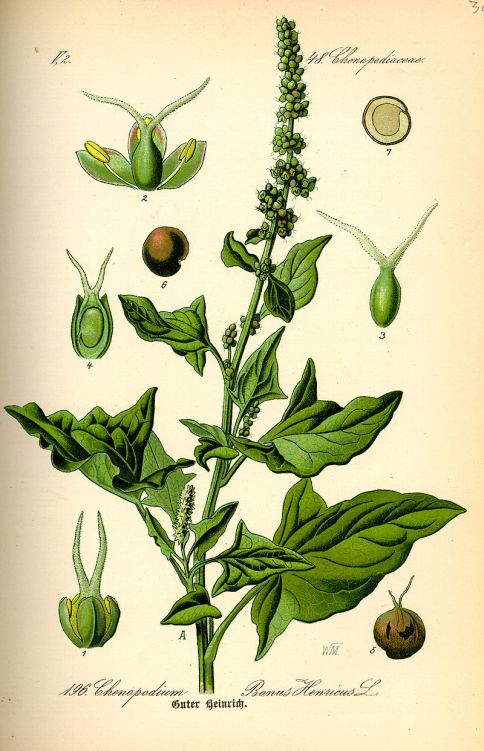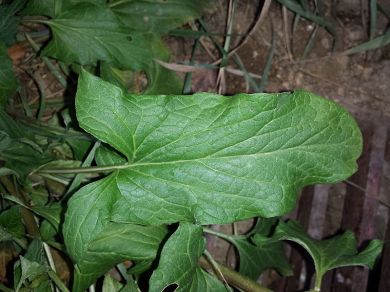Tags

Good King Henry, aka Fathen, wild spinach, English Mercury (in America sometimes corrupted to Markery), goosefoot, or Allgood is not native, but was grown in the U.S. at least by the early 1840’s, perhaps longer. It is perennial and can be propagated by self-sowing and by root division should you wish to share with your neighbor. Plant it in a prepared bed where it can grow unmolested and refrain from harvesting until the third year after which it will feed you for years to come.

Photo: Stefan Lefnaer, Wikimedia.
“We would particularly recommend to our readers, as a first-class vegetable for early spring use, the Good King Henry (Chenopodium Bonus Henricus), or English Mercury. This is, in many parts of England, Scotland, and Ireland, a rather common roadside weed, with a thick fleshy root, like that of a Dock, and grows to a considerable height. The lower leaves resemble those of Spinach, and are of a broadly triangular shape, often more than 3 inches long, stalked, sinuate, or slightly toothed, rather than thick and fleshy, and of a dark green colour. This upper ones are smaller and nearly sessile. It is extensively grown by the Lincolnshire farmers, almost every garden having its bed, which if placed in a warm corner and well manured, yields an abundant supply of delicious vegetables for a fortnight or three weeks before the Asparagus comes in, and for some weeks afterwards. From a south border we generally commence cutting the Mercury early in April, and continue cutting until the end of June. Some of our friends say they like it better than Asparagus; but we cannot go that length, though we like it very much. When properly grown, the young shoots should be almost as thick as the little finger, and, in gathering, it should be cut under the ground something the same as Asparagus. In preparing it for use, if the outer skin or bark has become tough, strip it off from the bottom upwards, and then wash and tie it in bunches like Asparagus. It is best boiled in plenty of water, with a handful of salt added. When tender, strain and serve simply, or upon a toast. Some have melted butter with it, others eat it simply with the gravy of the meat. Now, in cultivation, the Mercury will grow anywhere; but, to have it in the best form, superior cultivation is necessary. To this end you cannot have the ground too deep nor too rich. Hence we should say trench the ground2 feet deep, mixing in abundance of rich manure, and plant as early in the spring as possible. As the plant is a perennial, it is necessary to get an abundant yield of shoots, and to get them as strong as possible—and hence, in time, each plant may be a foot or more in diameter. In planting, we generally put the rows 18 inches apart, and the plants 1 foot apart in the row; and, after we begin to cut, we drench the ground frequently with manure water, or sprinkle the ground with guano in showery weather. Of course the plants must not be cut too severely until they are thoroughly established—say in the third year—and then you can scarcely injure them.” – “The Garden Illustrated Weekly Journal”. London. April 19, 1873.
In flavor it is comparable to spinach or asparagus. The shoots may be peeled and prepared as asparagus cooked as greens (alone or mixed with other plants), or put into soup and stew. Perhaps one of the following appeals to your taste. Some suggested adding the seed to soup and stew in the manner of quinoa.
GOOD KING HENRY (Boiled leaves). 1916. Have the leaves well washed, put into a stewpan with the smallest possible amount of boiling water, and let boil for fifteen minutes; then add a little salt, and boil five minutes longer. Strain off the water and chop the leaves finely. Have ready hot in a stewpan about one ounce each of butter and flour, with a little pepper and salt, add the leaves, mix well, and heat thoroughly for another five minutes. Serve hot with garnish of fried sippets (toasts).
GOOD KING HENRY (Boiled Shoots and Stalks). 1916. Prepare and cook as asparagus, and serve with any sauce suitable to asparagus. Keep any cold, cooked stalks for salad. ©

The funny names make it more appealing. There is a native version of it here, but it should be eaten only in moderation. (I just don’t eat it at all.) Surprisingly, there are a few of those sorts of old vegetables that were released here so long ago that I think of them as natives. Mustard is of course the most obvious, and actually happens to still be one of my favorites because it was so familiar as a cover crop under the apricot and prune orchards decades ago.
I like the idea of having these options even if I don’t eat them regularly, or even not at all. The rabbits and poultry can have them or they can even enrich the compost pile and the cover crop idea is much preferable to the grass I battle every year. We won’t go into my conspiracy theories, but I grew up in the South listening to stories of hardship during the Depression and how valuable any kind of green was because it could be harvested and it would replenish itself in a few days.
Okies (who we consider to be Southerners) are an important part of our history here (although most of our history has been modified to suit those who are here now). Many left Oklahoma when food was scarce, and employment to provide money to purchase food was even more scarce. Some arrived in the Santa Clara Valley at a time when the formerly vast orchards were being removed so that tract homes could be built. Although the construction of the tract homes provided employment, the destruction of the orchards was difficult to watch. On the outskirts of most tracts of homes, remnant orchard trees continued to produce fruit that the Okies continued to dry and can. The mustard that was once a cover crop in the orchards became a favorite green, just because it was so abundant. It is impossible to imagine all that now.
Very interesting, thanks for sharing.